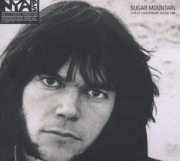 With the temperature dropping, it's time to find someone to keep you warm. Find your hookups with our online dating guide!
With the temperature dropping, it's time to find someone to keep you warm. Find your hookups with our online dating guide!
Sugar Mountain:
Live at Canterbury House, 1968
- Rock
- 2008
- Buy the CD
Reviewed by Lee Zimmerman
In the meantime, Neil’s given fans a recent pair of teasers to further heighten anticipation. Two live albums dating from the early ‘70s – Live at Massey Hall and Live at the Fillmore East – have spotlighted classic performances, both solo and in collaboration with Crazy Horse. Now he probes the archives once more to offer the ultimate sampling of the artist as a… ahem… Young man, thanks to a concert disc recorded in November 1968 in Ann Arbor, Michigan, not long after staking his departure from Buffalo Springfield and only days prior to the release of his eponymous debut solo album.
Sugar Mountain is made all the more enjoyable given the fact that includes sizeable chunks of that first album, which, although it’s rarely included in the canon of classic Young offerings, still ranks as one of his most satisfying accomplishments, an example of the artist in purely evocative songwriter mode. The highlights are represented here – the rambling, analogy-laden narrative "Last Trip to Tulsa," the shuffling, indelible "The Loner," the wistful ballads "If I Could Have Her Tonight," "I’ve Been Waiting For You" and "The Old Laughing Lady" – as well as revisits to the cream of his Springfield contributions -- "On The Way Home," "Out Of My Mind," "Broken Arrow" and "Nowadays Clancy Can’t Even Sing." Each tune is rendered in turned-down acoustic mode, giving a plaintive nod to songs that were generally more effusive in their original incarnations.
It’s a credit to Young and his somewhat arched sense of humor that he laments his seeming lack of ability to write real upbeat songs. Contrary to the forlorn demeanor he exhibits on record, his between-song patter and personal anecdotes are surprisingly spry and even self-effacing at times. That’s especially true when he recounts his brief tenure as a book store clerk, an episode subverted by an unfortunate encounter with a supply of amphetamines. Then again, that’s part of Young’s charm, the ability to teeter on a divide between mellow and mayhem.
You can follow us on Twitter and Facebook for content updates. Also, sign up for our email list for weekly updates and check us out on Google+ as well.











